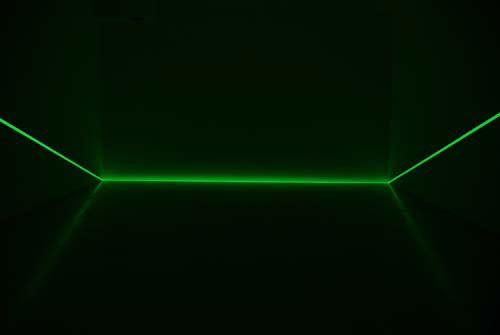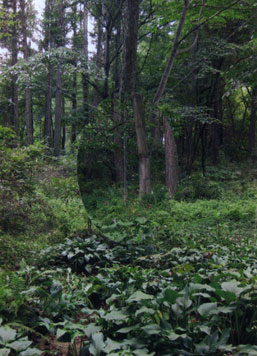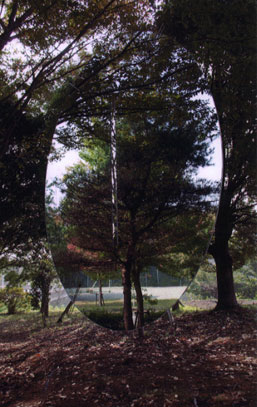Line, Space, and Yourself
Hidden in an innocuous part of Omotesando’s Musee F, I had nearly missed Chise Shimomura’s latest solo exhibition “sightseeing room”. Granted, I was looking for her “floating sight #2” installation instead, so encountering the darkened room instead of her large sand-blasted mirrors did alter my perception and expectations.
As I pushed past the heavy black curtains and entered, there was a brief moment of confusion as my eyes adjusted to the sudden darkness and searched for any flicker of light, which came in the form of a thin strip of glow-in-the-dark tape which ran across the walls of the room. Once accustomed to the room, I began to circle the four walls, tracing the tape with my eyes. It’s curious to note how standing at the different position in the room alters your perception of the lines, and the shape of the lines, ever so slightly. Crouch down and immediately you feel the walls start to close in on you. Altering the space-time continuum in this space is part-and-parcel of the experience.
“sightseeing room” resonates with Shimomura’s previous work (“image of line”, “floating sight”) in the way that she plays with different spaces, this time dividing each “space” with the defining line that cuts through the observer’s sense of spatial depth and reality. In representing space itself, Shimomura controls and confuses our visual perception, allowing us to slowly realize how much we can or cannot capture by merely ‘seeing’ something or someone.

There is nothing groundbreaking in Shimomura’s piece; but that does not stop her from manipulating the seemingly given of putting “light” and “dark” together in “sightseeing room”. Instead, the almost disconcerting simplicity of a dark room and softly glowing tape seems to explore the limits of living in an increasingly visual world. The sheer customizability of her piece, being able to fit into nearly any enclosed area, also presents a new way of creating ‘portable art’: art that not only transcends space but is not restricted by any space it inhabits.
Yet this case of mistaken identity was a blessing in disguise and perhaps very much akin to Shimomura’s aesthetic vision. Stumbling upon “sightseeing room” was reminiscent of the act of sight-seeing in a foreign country; its freshness serves as a palatable introduction to contemporary art for even the art-weary visitor. Against a backdrop of other art forms which scream loud colors and newfangled technological inclusions, “sightseeing room” is comforting in its contrast.
“sightseeing room” inhabits the small space until the end of this week.


Alicia Tan
Alicia Tan



